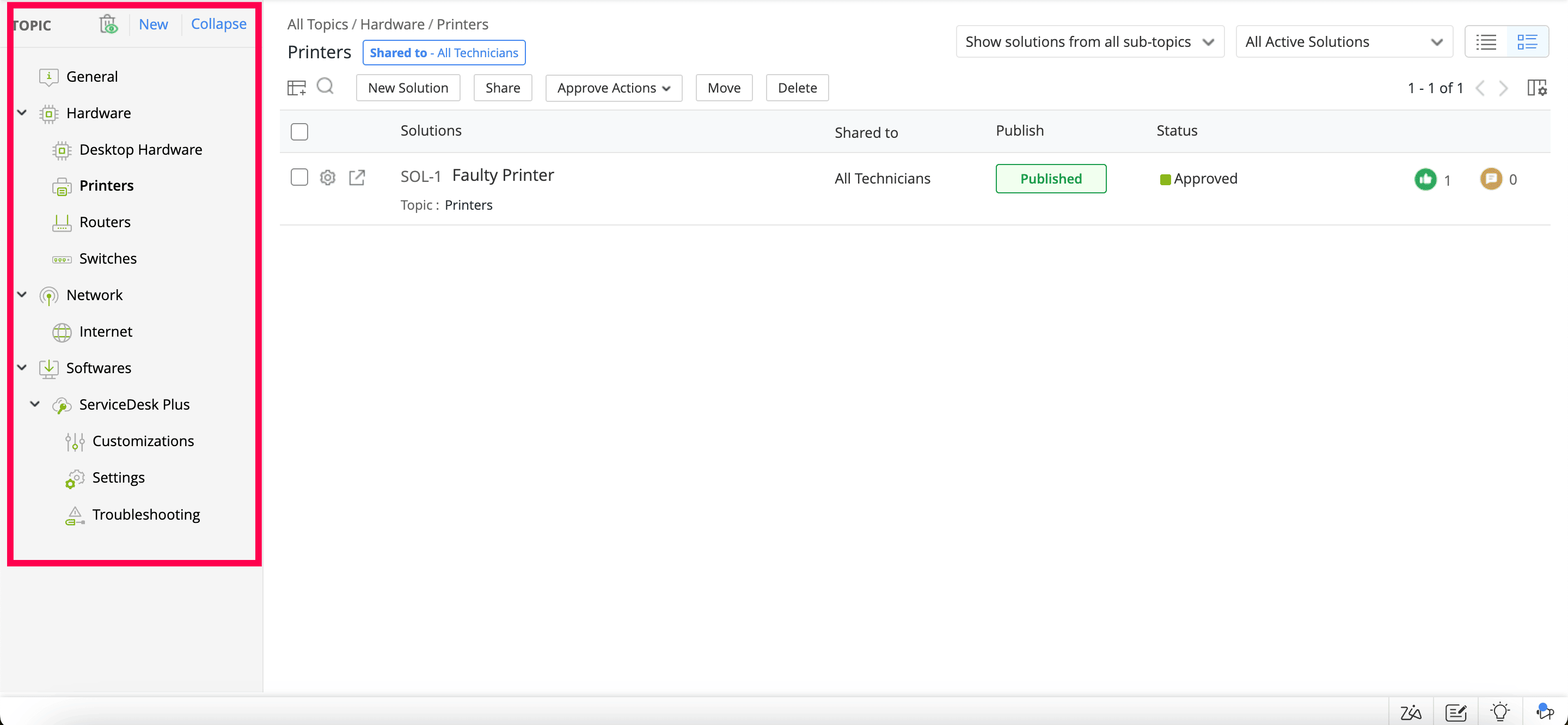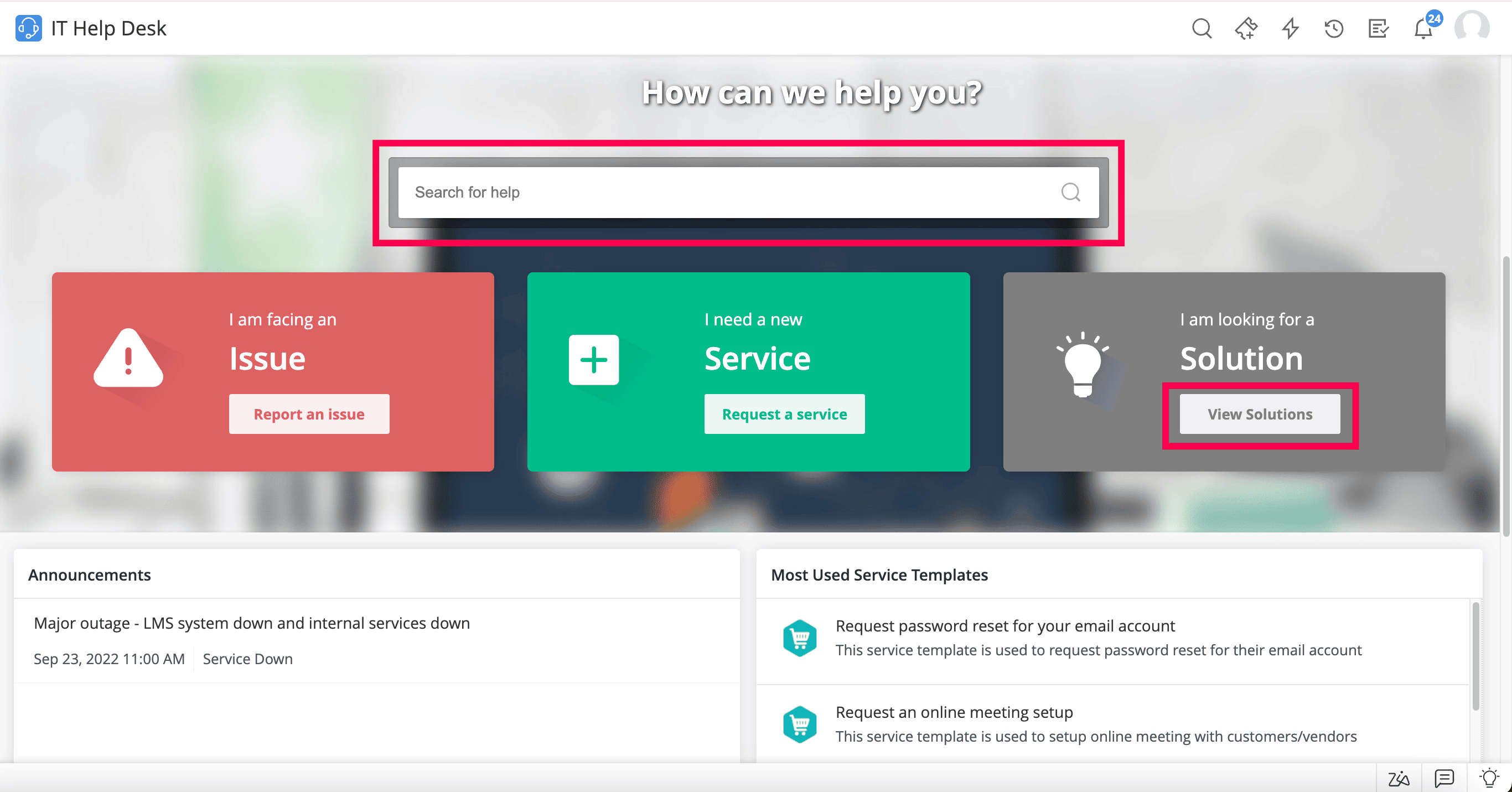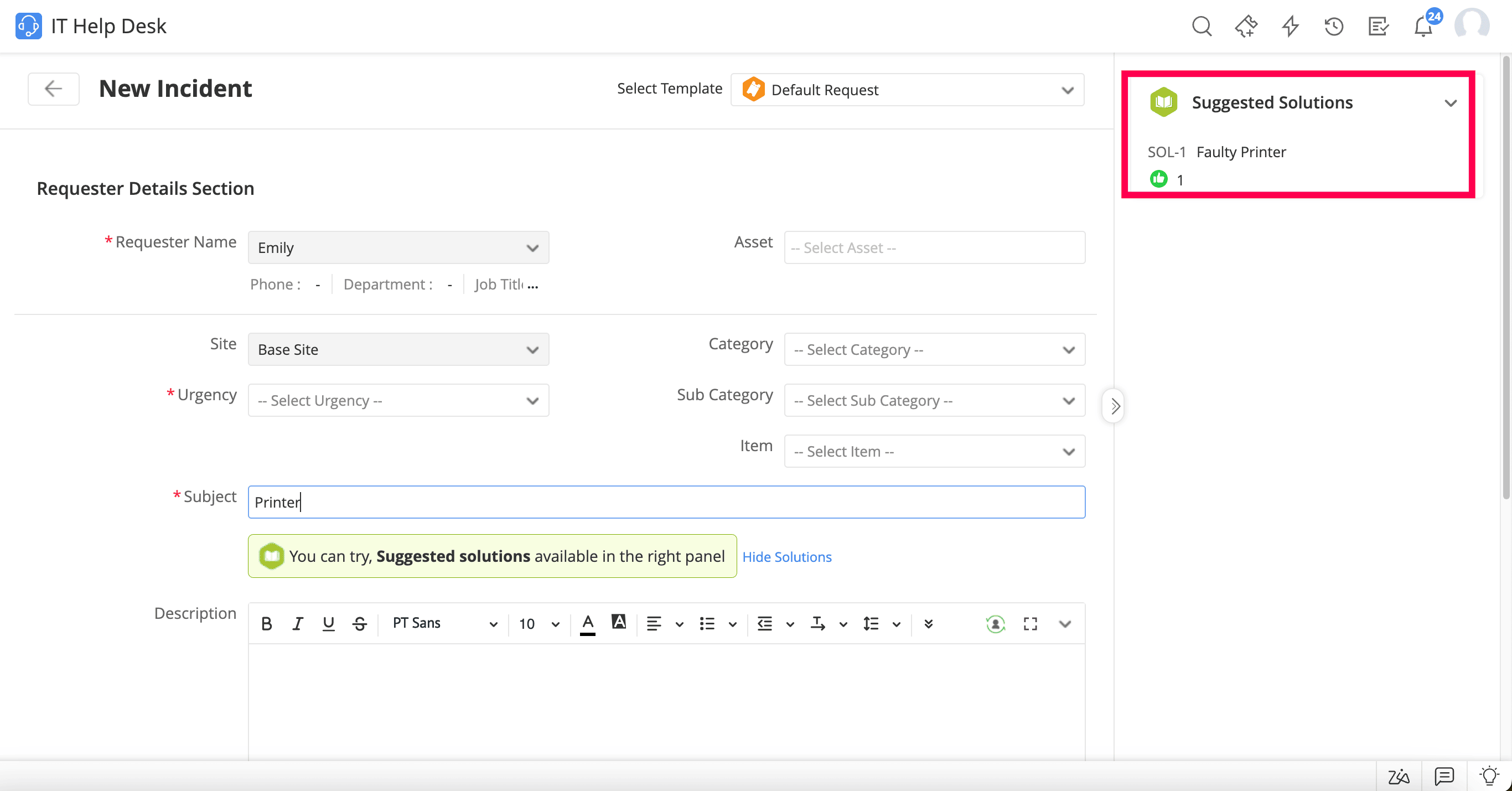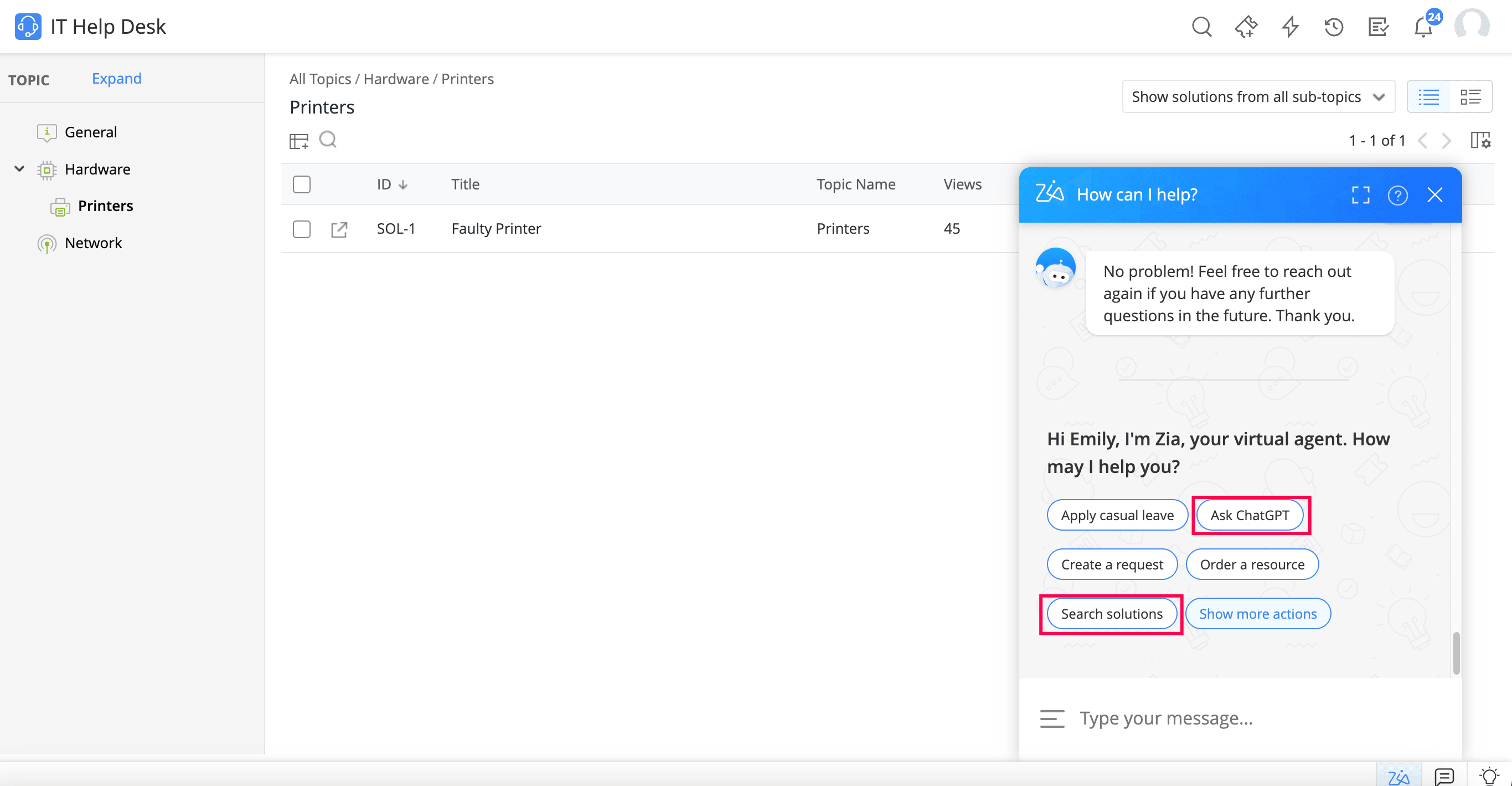ServiceDesk Plus: An exemplification of a built-in knowledge management system
October 15 | 07 mins read

Imagine working at a bustling IT service desk, constantly dealing with a barrage of support tickets. Every day brings new challenges, from troubleshooting technical issues to maintaining smooth service operations. Each resolved ticket presents an opportunity to document solutions and enhance your knowledge, enabling quicker resolutions for similar tickets in the future.
In this hectic environment, how can you ensure that important solutions, knowledge, and insights aren't lost? This is where a knowledge management system comes into play. Knowledge management involves systematically documenting the solutions and making sure they are readily available to technicians and end users when needed. How much more impactful would it be to have a knowledge management system within an IT service management (ITSM) framework?
Having a built-in knowledge management system ensures that valuable knowledge is seamlessly woven into various ITSM processes, such as incident, problem, change, and service request management. In this article, we will explore an example of such a knowledge management system.
So, what is a knowledge management system?
A knowledge management system is a tool or software designed to help organizations capture, organize, store, and share knowledge and information. By making relevant information easily accessible to employees, a knowledge management system allows IT service desk agents to resolve incidents quickly, reducing resolution time. Additionally, it empowers end users to find answers independently, reducing IT support requests.
In simpler terms, a knowledge management system is like a digital treasure chest where IT experts can store their valuable insights for future use. Imagine it as a virtual library filled with troubleshooting guides, best practices, FAQs, and insider tips—all designed to help you handle common IT issues with ease. By maintaining a well-organized knowledge base and making it easily accessible to end users, a knowledge management system promotes a culture of self-service and do-it-yourself (DIY) problem-solving. This not only empowers users to solve problems on their own but also saves valuable time for IT service desk agents.
"If you have knowledge, let others light their candles in it." — Margaret Fuller
Bloomfire and Notion are a few examples of products in the knowledge-sharing category. However, ServiceDesk Plus, an ITSM platform with integrated knowledge management system, offers maximum benefits for IT service desk teams by seamlessly combining service management and knowledge management. This integration facilitates the seamless incorporation of knowledge across diverse ITSM processes, including incident management, problem management, and change management.
For example, IT service desk agents can quickly access relevant knowledge articles to resolve incidents, link solutions to problems, and follow documented best practices for implementing changes. A knowledge management system also powers self-service portals, allowing end users to resolve common issues independently, reducing the volume of incoming tickets.
The knowledge management capabilities of ServiceDesk Plus are meticulously crafted to facilitate the creation, storage, dissemination, and utilization of organizational knowledge. Here is an overview of the knowledge management features offered by ServiceDesk Plus:
Article creation, templates, and approval
Ever wanted to create a treasure trove of knowledge articles? ServiceDesk Plus makes it a breeze! From how-tos and troubleshooting guides to FAQs and best practices, you can build a comprehensive knowledge base. The rich text editor lets you format articles and add images, links, and other multimedia content with ease. With predefined templates, you can ensure every article is standardized. And don't worry about quality—approval processes are in place to make sure the quality of every article is up to standards before it goes live.
Categorizing and tagging
Picture a world where finding the right article is as easy as pie. With ServiceDesk Plus, you can organize articles into tidy categories and subcategories for easy access. Tagging articles with the right keywords makes searching a breeze. Need to ensure your info stays fresh? Set expiration dates to keep your knowledge base current and relevant, maintaining peak accuracy and utility.

Advanced search
Need to solve a tricky problem? Just type a few keywords into the search bar, and you are greeted with a wealth of solutions at your fingertips, neatly organized for your convenience. You can filter and sort results by date, category, and more. It's like having a detailed map of where to find the answers to all your questions. The below figure depicts the self-service portal within ServiceDesk Plus, allowing end users to either input keywords or browse through the knowledge base for solutions.

Role-based access
Want to keep your knowledge secure and organized? You can define who can view, create, or edit articles based on their role. Make articles public for everyone or private for select groups. It's all about giving the right access to the right people.
Notifications
Stay in the loop with notifications! ServiceDesk Plus keeps you informed about updates to knowledge articles, approval status changes, and more. This way, you and your team are always aware of the latest information and can act swiftly to maintain the knowledge base.
Integration and auto-suggestion
ServiceDesk Plus is a team player. With a built-in knowledge management system that integrates seamlessly with other ITSM practices like self-service, incident, and problem management, you can add new solutions from incident or problem tickets to your knowledge base, or link existing articles to incident and problem tickets for quick references and resolutions. Furthermore, ServiceDesk Plus is proactive—when an end user tries to create a new ticket, it suggests relevant articles right away based on the keywords given in the subject of the ticket. The self-service portal provided by ServiceDesk Plus ensures that end users have 24/7 access to knowledge, reducing their need for IT support.

AI chatbot
Ever wish you had an intelligent assistant to guide technicians and end users to the right solutions? Meet Zia, the AI chatbot from ServiceDesk Plus. It transforms knowledge management into an interactive, dynamic process, guiding users to the right solutions through natural language interactions and offering concise summaries of detailed articles. With the ChatGPT integration, you can search for solutions from both internal and external sources, making your knowledge base smarter and more responsive than ever.

Tracking and optimization
Wondering how your knowledge articles are performing? You can track key metrics like article ratings, search trends, and views through surveys in ServiceDesk Plus. With these insights, you can refine your strategy, making your knowledge base even better. It's all about boosting service quality, cutting resolution times, and keeping users happy.
Bottom line
Knowledge management offers something valuable for everyone. Regardless of your business or industry, every department within your organization possesses crucial knowledge worth sharing. This includes IT, HR, legal, marketing, finance, and more—each of these areas has information that needs to be continuously shared with teams or the entire organization.
By pooling your collective wisdom, you can build a knowledge base that is both robust and reliable. Leveraging a knowledge management system like ServiceDesk Plus ensures that valuable knowledge is preserved, easily accessible, and effectively utilized.
Try the 30-day, free trial to discover how ServiceDesk Plus can empower your organization with an efficient knowledge management strategy.
